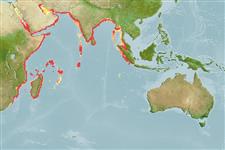Common names from other countries
Malacostraca |
Decapoda |
Penaeidae
Environment: milieu / climate zone / depth range / distribution range
Ecology
Benthic; brackish; depth range 1 - 170 m (Ref. 8), usually 10 - 30 m (Ref. 8). Tropical, preferred 26°C (Ref. 107945); 30°N - 31°S, 29°E - 103°E
Indo-West Pacific and Southern Atlantic. Introduced in the Mediterranean. Tropical to subtropical.
Length at first maturity / Size / Weight / Age
Maturity: Lm 12.7, range 11 - 12 cm Max length : 19.9 cm TL male/unsexed; (Ref. 119750); 22.6 cm TL (female); max. reported age: 2.50 years (Ref. 104940)
Maximum carapace length: 5.0 cm (female; Ref. 8). Prefers bottom sandy mud (Ref. 8). Also occurs on seagrasses, mudflats, sandflats and mangrove channels. Frequently burrows (Ref. 106912). Feeds on crustaceans, polychaetes, mollusks, fishes, algae and detritus (Ref. 104916).
Mating behavior: Precopulatory courtship ritual is common (through olfactory and tactile cues); usually indirect sperm transfer (Ref. 833). Females spawn once every two (2) months (Ref. 104933).
Holthuis, L.B. 1980. (Ref. 8)
IUCN Red List Status
(Ref. 130435: Version 2025-1)
CITES status (Ref. 108899)
Not Evaluated
Not Evaluated
Threat to humans
Human uses
Fisheries: commercial; bait: occasionally
FAO - Fisheries: landings | FishSource | Sea Around Us
Tools
More information
PhysiologyOxygen consumption
Human RelatedStamps, coins, misc.
Internet sources
Estimates based on models
Preferred temperature
(Ref.
115969): 25.2 - 29.3, mean 27.8 (based on 258 cells).
Resilience
High, minimum population doubling time less than 15 months (K=0.67-2.2; tmax=2.5).
Prior r = 1.11, 95% CL = 0.74 - 1.67, Based on 2 data-limited stock assessments.
Fishing Vulnerability
Low vulnerability (11 of 100).
Climate Vulnerability
Moderate to high vulnerability (49 of 100).
Nutrients : Calcium = 109 [35, 184] mg/100g; Iron = 1.59 [1.21, 1.97] mg/100g; Protein = 20.2 [19.2, 21.3] %; Omega3 = 0.285 [0.185, 0.386] g/100g; Selenium = 48.3 [-31.7, 128.3] μg/100g; VitaminA = 0 μg/100g; Zinc = 1.79 [1.17, 2.40] mg/100g (wet weight); based on
nutrient studies.
